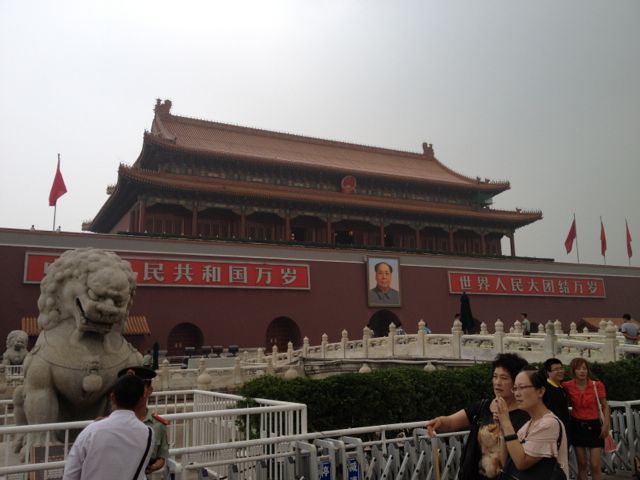Absolutely! What a finale to my visit in Beijing. It was a whirlwind 2 days, but I will attempt to give you some of the highlights that I remember from the fountain of information supplied by Mark, my trusty tour guide.
First let me say that as I was told beforehand, Beijing is an absolutely massive city- with 18 million inhabitants it seems dense yet sprawling at the same time. Our first stop on day 1 (at the un-musicianly hour of 7:30 a.m.) was Tiananmen Square.

This huge area can hold up to half a million people and is named for the gate on its north side- Tiananmen, which translates to Gate of Heavenly Peace. Behind Mao's picture are seating areas for officials, and Mao's mausoleum resides in a separate building in the square. This gate marks the entrance to the area enclosing the Forbidden City, once the residence of China's Emperors.

Just inside the gate above is the Meridian Gate (below) marking the official entrance to the Forbidden City- the entrances are square on the outside (representing earth, which they believed was square) and round on the inside (representing heaven, as the emperor is the people's connection to heaven). Also, only the Emperor himself was allowed to use the middle entryway- there were at least 2 entrances on either side for people of descending importance.

You've probably seen the outer court before- The Last Emperor, anyone?

Entering the area where the Emperor's concubines lived (up to 3000 for one emperor), the lions at this entrance have their eyes shrouded and ears folded- this is to advise all who enter to avert their eyes and close their ears, lest they be tempted by any of the ladies that belong to the emperor alone.

Each main hall in each successive court contained a throne- as I discovered, you've seen one throne room you've pretty much seen them all. So here's one.

There is no foliage in the Forbidden City until you get past the Emperor's quarters to where the concubines live- this is because they could provide a hiding spot for a would-be assassin. The concubines had a garden to hang out in, perhaps as a consolation prize- they had no contact with their families while living in the Forbidden City.

The Forbidden City is surrounded by a huge moat, which I believe is 50 meters wide.

Our next stop was the Temple of Heaven, which covers even more ground than the Forbidden City, but with less structures and more parkland. This is where the Emperor went twice a year (on the winter and summer solstices) to pray for good harvests on behalf of his people (of course, it is round in shape- anyone see a theme emerging?)

There were lots of people hanging out here, some playing a kind of tennis/badminton hybrid- some playing card games, and some kicking around a hacky sack with feathers.

And our final visit that day was to the Summer Palace- which is not actually a palace but a series of buildings dominated by Longevity Hill with imperial gardens and a man-made lake. The hill is pictured below with the Tower of Buddhist Incense in the centre, which we climbed (emitting much perspiration in the process).

From the top we had a good view of the buildings below, the lake and a man-made island in the middle- reachable on foot by a bridge, or by boat.

Another feature is the Long Corridor, an extremely long covered walkway adorned with brightly painted pictures and designs.

And that brings us to day 2, which started off with a visit to the Ming Tombs- which as per the title house the bodies of 13 emperors of the Ming Dynasty. The main tomb (is it me or does the map look like a Star Trek ship or something?) belongs to the third emperor of the Dynasty, but the first one to move the capital of China from Nanjing to Beijing.

As you can see, it has a square area (an area designated for earthly work) and a round area (where the body is buried, representing heaven). Emperors were buried with material goods, supposedly because their spirits would be able to use them in the afterlife. They were also buried with some their favourite concubines, often buried standing up to await their emperor in the afterlife- and one on top of the other! This apparently was one such burial place:

The other tombs are spread out around Yongle's, and the entire group are surrounded by hills on 3 sides- here is one view of another tomb, barely visible in the distance between the 2 closest peaks.

And finally we arrived at the Great Wall- or rather, at the base of the cable car to get to the Badaling section of the Wall. The area was a madhouse, cars and buses parked everywhere with others trying to get in and out- every inch of space crawling with vehicles. After a long wait to board the cable car, here was our first view of the highest point of this section.

As you can see, the series of steps and ramps leading up to it are quite steep in places!

Finally the top was within reach.

But the views were worth it all, you can see the wall stretching as far as the horizon in several directions.


Wish we could have walked more of the wall, but the cable car was closing soon- so back down we went.

What a trip- so much to take in, so much amazing history. Hope you enjoyed the little taste that I've presented for you! If so, please feel free to spread the word by sharing this blog.
Next week, Singapore! Time to sleep- til we blog again,
J.
